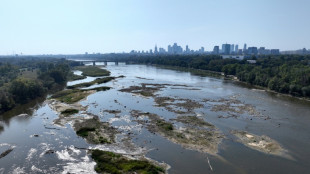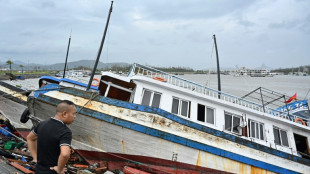
-
 Vatican thriller 'Conclave' drums up Oscars buzz in Toronto
Vatican thriller 'Conclave' drums up Oscars buzz in Toronto
-
More civilians killed hours after Sudan rejects UN experts' report

-
 Ronaldo strikes late to seal Portugal win over Scotland
Ronaldo strikes late to seal Portugal win over Scotland
-
Drought sinks longest Polish river to record-low level

-
 East Timor prepares for first papal visit since independence
East Timor prepares for first papal visit since independence
-
Tearful Sinner dedicates US Open title to seriously ill aunt

-
 Three things on US Open champion Jannik Sinner
Three things on US Open champion Jannik Sinner
-
Ten-man Spain sink Switzerland in 4-1 romp

-
 Hill sparks Dolphins comeback in wild NFL opening day
Hill sparks Dolphins comeback in wild NFL opening day
-
Sinner sweeps to US Open title for second Grand Slam triumph

-
 Smith heroics for England remind Collingwood of Gilchrist
Smith heroics for England remind Collingwood of Gilchrist
-
Thousands protest Mexican judicial reform

-
 Nissanka leaves Sri Lanka in sight of third Test win over England
Nissanka leaves Sri Lanka in sight of third Test win over England
-
Kendrick Lamar to headline 2025 Super Bowl halftime show

-
 Thousands defy roadblocks in rally for Pakistan ex-PM Khan
Thousands defy roadblocks in rally for Pakistan ex-PM Khan
-
Roglic wins record-equalling fourth Vuelta

-
 Russia advances in east Ukraine, launches deadly air strikes
Russia advances in east Ukraine, launches deadly air strikes
-
Cowboys quarterback Prescott agrees record $240 mln extension

-
 Swiss double in Paralympic wheelchair marathons, Dutch women retain basketball title
Swiss double in Paralympic wheelchair marathons, Dutch women retain basketball title
-
New 'Beetlejuice' creeps its way to top of N.America box office

-
 South Africa captain Kolisi leaves Racing 92: French Top 14 club
South Africa captain Kolisi leaves Racing 92: French Top 14 club
-
Funeral for slain athlete Cheptegei in Uganda on Sept 14

-
 Dolphins star Hill arrested on way to season-opener
Dolphins star Hill arrested on way to season-opener
-
Smith hits back after England collapse against Sri Lanka

-
 Weather delays final regattas in Louis Vuitton Cup
Weather delays final regattas in Louis Vuitton Cup
-
Venezuela's Gonzalez Urrutia: from placeholder to opposition pointman

-
 Marquez thanks rain for San Marino MotoGP win as leader Martin pays for gamble
Marquez thanks rain for San Marino MotoGP win as leader Martin pays for gamble
-
Boeing, union reach preliminary deal to avert Seattle-area strike

-
 Neuville wins Acropolis Rally to close in on world title
Neuville wins Acropolis Rally to close in on world title
-
Venezuela's opposition figure fled to Spain to save 'his life'

-
 Trump, Harris tied on eve of televised presidential debate
Trump, Harris tied on eve of televised presidential debate
-
Paris Paralympics the greatest ever, say former Olympics executives

-
 Pope exit revives Sri Lanka's hopes in third Test against England
Pope exit revives Sri Lanka's hopes in third Test against England
-
Gunman kills 3 Israelis at West Bank crossing as Gaza war rages

-
 Marquez wins San Marino MotoGP as leader Martin pays for rain gamble
Marquez wins San Marino MotoGP as leader Martin pays for rain gamble
-
Greece to hike fee for cruise passengers to Mykonos and Santorini

-
 Carsley's 'refreshing' England overhaul launches new era
Carsley's 'refreshing' England overhaul launches new era
-
Swiss double in wheelchair marathons on final day of Paralympics

-
 France's Le Pen urges Macron to hold referendum to break deadlock
France's Le Pen urges Macron to hold referendum to break deadlock
-
Typhoon Yagi weakens, toll rises to 14 in Vietnam

-
 India's Randhir Singh elected Asian Olympic chief
India's Randhir Singh elected Asian Olympic chief
-
Under pressure, UN winds down 'unique' Iraq probe into IS crimes

-
 'Proud' athletics great Weir calls time on marathon Paralympic career
'Proud' athletics great Weir calls time on marathon Paralympic career
-
'Brave' Afghanistan can beat anyone, says skipper ahead of NZ Test

-
 Vaughan warns England against 'taking the mick' after Sri Lanka collapse
Vaughan warns England against 'taking the mick' after Sri Lanka collapse
-
England's Moeen Ali retires from international cricket

-
 Japan's Hirata holds off inspired Smyth to win on Asian Tour
Japan's Hirata holds off inspired Smyth to win on Asian Tour
-
China's Paralympic domination fails to ignite enthusiasm back home

-
 Sporting a feathered headdress, Pope finds 'Eden' in Papua New Guinea
Sporting a feathered headdress, Pope finds 'Eden' in Papua New Guinea
-
Super Typhoon Yagi toll rises to 9 in Vietnam after landslide


From DC's 'forgotten' river to the Seine, pollution cancels swim events
Pollution may be forcing postponements for Olympic events in the Seine, but on the banks of the Anacostia River in Washington, Dennis Chestnut is also canceling his swimming plans, thwarted by similar contamination.
Once known for half-submerged tires, floating detritus and tumor-laden catfish, the Anacostia, sometimes called the US capital's "forgotten river," has undergone a drastic transformation in recent years.
Remediation has been so profound that advocates organized what was to be the Anacostia's first legal swim in more than 50 years, after officials in 1971 banned entering due to water quality concerns.
But two attempts at the event this summer, as well as two in 2023, were ultimately canceled -- twice for high levels of E.coli or water quality concerns and twice for poor weather. The sewage-indicating bacteria is also behind the Olympics postponements.
Chestnut, who as a boy learned to swim in the Anacostia, which flows through predominantly African-American sections of the city, had been slated to jump in along with around 200 others under special permission for the one-time event.
At age 75, the Anacostia advocate remembers when he, his siblings and friends would splash along the river's banks in the 1950s and '60s, with swimming pools largely off-limits or segregated for Black Americans.
It was a more innocent time for the river, before it became synonymous with toxicity and a known dumping ground for sewage, chemical contaminants and trash.
- 'Swimmable days' -
"Every river is unique, though the Seine and the Anacostia are both impacted by E.coli, which is common among rivers in areas with older sewer infrastructure," Quinn Molner, director of operations at Anacostia Riverkeeper (ARK), the nonprofit that staged the swim event, told AFP.
French authorities had invested $1.5 billion over the last decade to clean up the Seine, including in major new water treatment and storage facilities in and around Paris.
Washington had invested in a similar multi-billion dollar system under its Clean Rivers Project, building tunnels that substantially reduce combined sewer overflows (CSOs).
The overflows occurred when untreated water including sewage flowed into Washington's rivers during storms so as not to overwhelm treatment plants.
The new tunnels are expected to reduce the overflows in the Anacostia by 98 percent.
"We now see some locations in the Anacostia with safe levels of E. coli for swimming upward of 80 percent of the time," Quinn told AFP.
But Chestnut, who spoke to AFP from a lily pad garden on the river's edge, emphasized that "swimmable days are good, but you know, we really need it to be just generally swimmable."
- Legacy contaminants -
On hot summer days as a kid, he and friends would travel down a neighborhood tributary to the Anacostia's banks, where they would swim next to a riverside landfill.
The landfill "definitely contributed to the pollution and the toxic pollutants in the river," Chestnut said.
Additionally, heavy industry and dumping along the Anacostia's banks have left a legacy of major chemical contamination that remains to this day.
Of particular concern are polychlorinated biphenyls (PCBs), industrial chemicals banned in the United States in 1979, which affect immune, reproductive, nervous and endocrine systems, and are likely to cause cancer -- they also bind to sediment.
But they are mostly a threat to fish and wildlife that live and forage along the river bottom.
Such chemical toxins are "present in such really tiny doses in the water column that they're not clinically significant" for swimming purposes, Trey Sherard, ARK's riverkeeper, told AFP.
As far as humans are concerned, the chemicals are a threat to those eating fish out of the river and have resulted in fish consumption advisories not only for those caught in the Anacostia but also Washington's better-known river, the Potomac.
Those toxins "aren't soluble in water, anything that's soluble in water would have been washed out a long time ago," Gretchen Mikeska, Anacostia coordinator for the Washington Department of Energy and Environment, told AFP.
As a result, a major Anacostia River Sediment Project was begun in 2013 with an aim of cleaning up legacy toxins in the sludge.
Despite the Anacostia's improved water quality, the long legacy of pollution, Chestnut said, dissuaded friends and family from signing up with him for the swim.
But he remains undeterred.
"I'm making it possible for them to be able to swim in the river going forward, and their children and their children's children are going to benefit from what we're doing," he said.
"Every place is not fortunate to have a natural resource like a river," Chestnut added.
J.Pereira--PC
